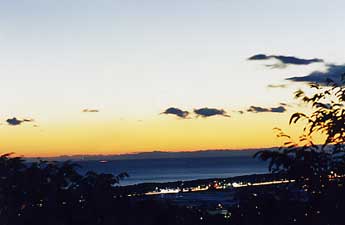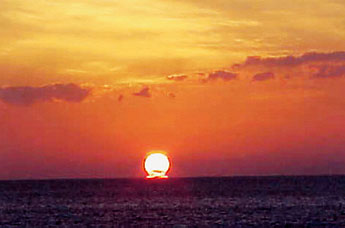
| Return |
|
• January 25 • January 21 The first time in many days I walked south for about 5 kilometers from home and climbed Mt. Washioyama rising high in the south. I was able to see Uradowan Bay and the expanse of the Pacific Ocean below. It was a magnificent view. I followed Comet Seki-Lines with Mr. Koichi Ike at Mt. Washioyama (Minor Planet 7274) in April 1962. Forty-two years have passed since! I kept on walking silently along the mountain roads staring at the shadow of myself who is still following comets and I was pondering on my life Mr. Ike, a stargazer friend of mine in those days, has moved to Chiba City and lives in unfamiliar surroundings. There are only few stargazer friends left of his and my generation. However, he had his name Ike given to Minor Planet 21022 this January. Incidentally, Mr. Ike is the first person who had successfully received television pictures in Kochi during a period between 1945 and 1955. He is also one of the first hams (amateur radio operators) in Japan. Since the discovery of Comet Okabayashi-Honda in 1940, he has searched for comets for almost half a century, but he hasn't been lucky enough to discover one. While walking the rugged mountain path, I found Mr. Ike with a soldier's cap on coming from the opposite direction. Looking at him closely, I found him a wrong person, though he resembled Mr. Ike. "Hi, how are you doing?" His spirited voice refreshingly faded in the wind. |
 At the summit of Mt. Washioyama  The shadow of myself who is still following comets. |
| • January 1 A Happy New Year! This was a peaceful, happy new year's day. I started observing at Geisei on the evening of the new year's day by the 60cm telescope. This year I aspire not only to observe known comets but to make discoveries. I saw a lot of cars moving to the east along the highway, 2km south of the observatory, from the new year's eve to the pre-dawn morning of the new year's day (Photo 1). These cars were heading for beautiful Cape Muroto-Misaki for worshipping the first sunrise of the year. Ms. Michi Minetomo, one of the visitors to the Cape, sent me the photo (Photo 2) below of a rare "Dharma-doll*"-shaped sun at the first sunrise of the year, which had been taken at Cape Oyama-Misaki in Aki City on the evening of January 3. (*)For an explanation on the dharma doll, try the following site: http://www.fightingarts.com/learning/history_subjects/ bodhid2.shtml |
 Photo 1: A view of National Highway 55 seen from the observatory  Photo 2: A Dharma-doll-shaped sun Photo by Ms. Michi Minetomo |
Copyright (C) 2004 Tsutomu Seki.